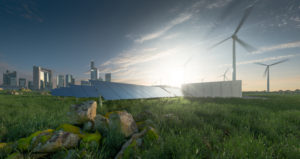Smart Cities. Smart Homes. Smart Phones. Smart Everything.

As the AIA’s 2030 Commitment comes into plain sight, let’s take a step back and look at how modern cities are being planned and how that will impact design strategies at the local level. Where terms like sustainability, mobility, net-zero and connectivity move from the macro to the micro.
From the outside looking in, it is obvious that cities are facing a vast array of challenges. One disadvantage is the fact that cities are comprised of competing political and social groups. Social issues are understandably high on the agenda for many leaders. Establishing the right conditions for a prosperous economy, one that creates jobs and promotes social equality in an era of life-altering digital transformation is of vital importance. Politically, cities are responsible for providing functional infrastructure that concurrently must be affordable and maintainable. And manageable.
Of vital importance is a working mobility/transportation system; but factors such as urban safety and disaster relief, adequate education and affordable healthcare options, and affordable housing all come into play. At the end of the day, it’s really all about what it takes to make a city somewhere people actually want to live their lives.
In an age of deteriorating and in many cases, obsolete energy grids, our cities also are compelled to ensure the cheapest possible supply of uninterrupted power, recycling and waste-management services, clean air and purified water, and the right conditions to kick start innovative new businesses and cutting-edge scientific discovery. And, to a great degree, how our aging population can live in place; community-wise as well as on an individual basis.
Here are just a few high-level touch points I see as critical to smart city architecture, and where our magazine will continue to focus our aspirations to educate and entertain. These three areas of concern that city planners are consumed with have a direct correlation with, and impact on, how neighborhoods will be designed in the future. And how our residential and light commercial technology will interface with large-scale software platforms that will drive our cities into the future.
Energy Management
Most urban areas are faced with the reality of an aging energy grid, as we’ve built far more infrastructure than the original specs were designed for. Power outages, brown-outs, surges and sags wreak havoc on sensitive micro-processors and the bitter reality is that things are only going to get worse unless we make wholesale changes.
It should be obvious to anyone paying attention that the production, storage and consumption of renewable energy is top of mind. How will renewable energy flow between power grids, heat networks, buildings and communities? What economic incentives will be created to make buildings and residences both consumers and producers? How will individual, single-family micro-grid residences connect into these larger-scale grids and how will they ‘talk’ to each other?
Transport Systems
If the goal is to depend on renewable energy, then our conventional public transportation systems have to change. Moving to an all-electric, self-driven vehicle plan entails charging technologies, booking and routing of traffic, and increased public mobility. Information systems that detail city-wide usage, incorporate ride-sharing methodologies and other aspects of maximum usage strategies means the inevitable obsolescence of private cars for city travel.
Software Platforms
Bringing all of the disparate technologies and policies together so combined data can be analyzed and processed will require new software platforms that will have the ability to look downstream into our homes to analyze at the micro level how we are generating, storing and using renewable energy. What software platforms at the residential level will interface with these macro platforms? How will the design of the modern performance home have to change to meet these new challenges? Will we get ahead of the curve and propose our own unique solutions or will we be regulated to conform to a new set of standards?
Final Thoughts
These are just a few of the questions that are going to impact city planning and neighborhoods that comprise the greater urban areas of the country. We’ll be keeping an eye on the macro and over the coming decade reporting on how smart cities will be impacting your design strategies at the micro level.
Smart cities offer the possibility of cleaner air and water, and more efficient mobility which reduces traffic and increase the quality of life in an urban environment. With better economic opportunities and a truly connected infrastructure, the future looks bright. Let’s make sure we play our role in designing and building sustainable and accountable residential, MDU and light commercial properties.

